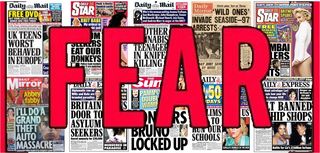Anxiety
Moral Panic: Who Benefits From Public Fear?
Moral panics maintain the status quo.
Posted July 20, 2015 Reviewed by Jessica Schrader

Public fear, and those responsible for creating or promoting it, are major topics of discussion these days. The sociological and criminological concept known as moral panic offers valuable insights into how and why powerful social agents such as the news media and politicians deliberately create public concern or fear of an individual or group.
Moral panic has been defined as a situation in which public fears and state interventions greatly exceed the objective threat posed to society by a particular individual or group who is/are claimed to be responsible for creating the threat in the first place.
The moral panic concept was developed and popularized by the late South African criminologist Stanley Cohen when he explained the public reaction to disturbances by youths called “mods and rockers” at seaside resorts in Brighton, England during the 1960's. Cohen’s work illustrated how those reactions influenced the formation and enforcement of social policy, law, and societal perceptions of threats posed by the youth groups.
Since its inception, the moral panic concept has been applied to a wide range of social problems including but not limited to youth gangs, school violence, child abuse, Satanism, youth wilding, flag burning, illegal immigration and the Iraq war.
Central to the moral panic concept is an argument that public concern or fear over an alleged social problem is mutually beneficial to state officials—that is, politicians and law enforcement authorities—and the news media. The relationship between state officials and the media is symbiotic in that politicians and law enforcement need communication channels to distribute their rhetoric and the media need tantalizing news content to attract a wide audience which, in turn, attracts advertisers.
Moral panics arise when distorted mass media campaigns are used to create fear, reinforce stereotypes and exacerbate preexisting divisions in the world, often based on race, ethnicity and social class.
Additionally, moral panics have three distinguishing characteristics. First, there is a focused attention on the behavior, whether real or imagined, of certain individuals or groups that are transformed into what Cohen referred to as “folk devils” by the mass media. This is accomplished when the media strip these folk devils of all favorable characteristics and apply exclusively negative ones.
Second, there is a gap between the concern over a condition and the objective threat it poses. Typically, the objective threat is far less than popularly perceived due to how it is presented by authorities.
Third, there is a great deal of fluctuation over time in the level of concern over a condition. The typical pattern begins with the discovery of the threat, followed by a rapid rise and then peak in public concern, which then subsequently, and often abruptly, subsides.
Finally, public hysteria over a perceived problem often results in the passing of legislation that is highly punitive, unnecessary, and serves to justify the agendas of those in positions of power and authority.
Moral panic is both a public and political response to an exaggeration or distortion of the threat posed to society by some allegedly harmful individual or group. More specifically, moral panic includes an exaggeration of certain events by enhancing the empirical criteria such as the number of individuals involved, the level and extent of violence, and the amount of damage caused.
Of course, this is not something that happens spontaneously, but rather, is a result of the complex dynamics and interplay among several social actors. As originally explained by Cohen, at least five sets of social actors are involved in a moral panic. These include: 1) folk devils, 2) rule or law enforcers, 3) the media, 4) politicians, and 5) the public.
First, in the lexicon of moral panic scholars, folk devils are those individuals who are socially defined or alleged to be responsible for creating a threat to society. Unlike some deviants, folk devils are completely negative. They are the embodiment of evil and the antagonists in a moral panic drama.
Second, law enforcers such as the police, prosecutors or the military are vital to a moral panic as they are charged with upholding and enforcing the codes of conduct and official laws of the state. These agents of the state are expected to detect, apprehend and punish the folk devils. Law enforcers have a sworn duty and moral obligation to protect society from folk devils when they present themselves. Furthermore, law enforcers must work to justify and maintain their positions in society. A moral panic can offer law enforcers legitimacy and purpose by ridding society of folk devils that allegedly threaten its well-being.
Third, the media are a particularly powerful set of actors in the creation of a moral panic. Typically, news media coverage of certain events involving alleged folk devils is distorted or exaggerated. News coverage makes the folk devils appear to be much more threatening to society than they really are. Public concern and anxiety are heightened by journalistic hyperbole concerning the folk devils. Public concern and anxiety over the folk devils lead to moral panic.
Moreover, there are two important news media practices that contribute to moral panic. These are known as framing and priming. Framing refers to the way an issue is presented to the public or angle it is given by the news media. Framing involves calling attention to certain aspects of an issue while ignoring or obscuring other elements. In other words, framing gives meaning to an issue.
Dr. Gaye Tuchman proposed that the news media rely on “news frames” to determine what events to cover and how to cover them. Just as the photographer’s choice of lens affects a photograph, the journalist’s choice of news frame affects a story. Tuchman theorized that journalists select news frames for a story based in part on routine procedures and the organizational constraints of their particular medium.
In addition, the choice of frame is influenced by prior news frames, the power and authority of news sources, history, and even ideology. Thus, news frames are contested or negotiated phenomena rather than being based solely on objective events. Most importantly, an audience will react very differently to an issue or story depending on how it is framed by the news media.
In contrast, priming is a psychological process whereby the news media emphasis on a particular issue not only increases the salience of the issue on the public agenda, but also activates previously acquired information about that issue in people’s memories. The priming mechanism explains how the news frame used in a particular story can trigger an individual’s preexisting attitudes, beliefs and prejudices regarding that issue.
An example of priming would be the triggering of varied individual responses such as outrage or pity to the framing of Dr. Conrad Murray—Michael Jackson’s accused killer and personal physician—during his 2011 manslaughter trial. Given the news media’s prior framing of the legendary Michael Jackson as an eccentric and troubled genius, people naturally had different reactions to the framing of Dr. Murray due to their own individual interpretations of the image of Jackson.
Fourth, politicians are also vital actors in a moral panic drama. As elected officials who must operate in the court of public opinion, politicians must present themselves as the protectors of the moral high ground in society. Similar to law enforcers, politicians have a sworn duty and moral obligation to protect society from folk devils when they arise.
Politicians often fuel a moral panic by aligning themselves with the news media and law enforcers in a moral crusade against the evils introduced by the folk devils. In other instances, such as the U.S. war on drugs launched in the late 1980's, a key politician such as President Ronald Reagan may define the folk devils—that is, urban crack cocaine dealers—and precipitate a moral panic over the evils of crack cocaine and alleged threats these evils present.
The fifth and final set of actors, the public, is the most important player in the creation of a moral panic. Public agitation or concern over the folk devils is the central element of a moral panic. A moral panic only exists to the extent that there is an outcry from the public over the alleged threat posed by the folk devils.
Moreover, the success of politicians, law enforcers and the media in precipitating and sustaining a moral panic is ultimately contingent upon how successfully they fuel concern and outrage toward the folk devils among the public.
Can you think of a recent social phenomenon that can be considered a moral panic?
Scott Bonn is a criminologist, best-selling author, professor and TV analyst. Follow him on Twitter or visit his website.




